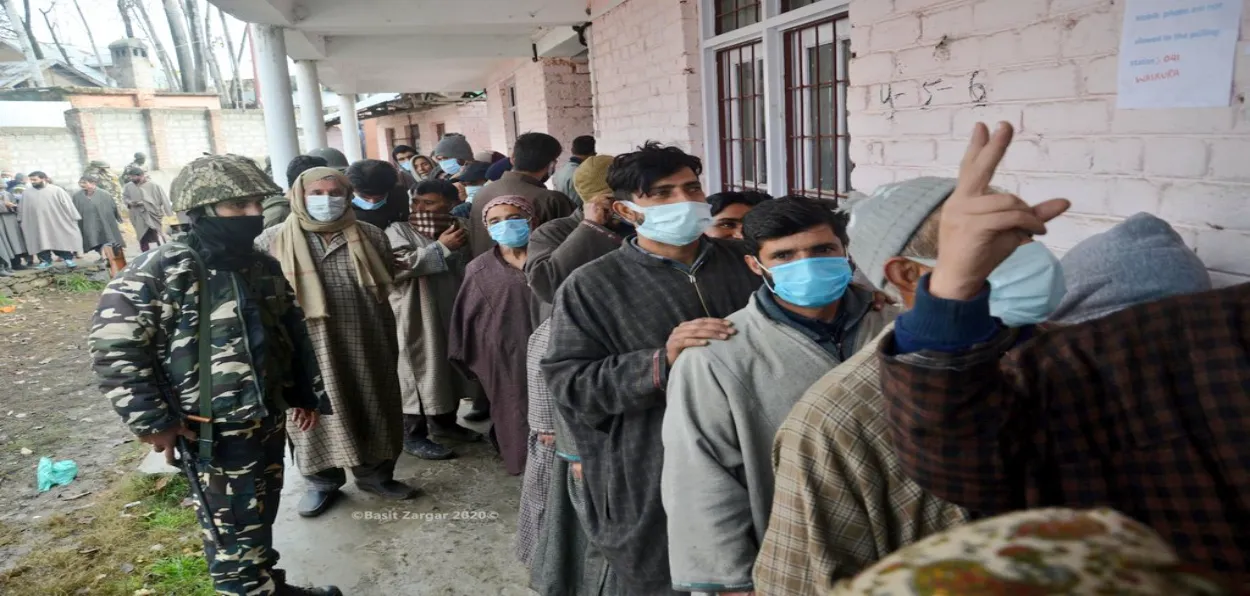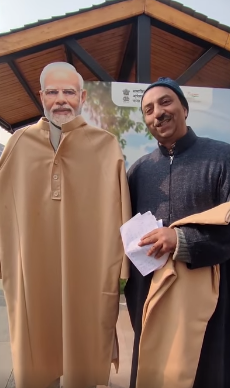
Ahmed Ali Fayyaz/Srinagar
With six elected MPs representing the people of Jammu and Kashmir, the State had the least visibility in the 543-member Lok Sabha. In a way, the country's highest law-making body was irrelevant for J&K’s voters till 2019 as all the laws made by it did not automatically apply to the State that enjoyed a special status under Article 370 till August 5, 2019.
Most of the laws passed by the Indian parliament had to be ratified by the State legislature.
“We were elected by the people of J&K but, till 2019, we made laws only for the rest of India, not J&K. The Parliament’s laws, with some exceptions, could be extended to J&K only through the J&K Legislature. Because of this, in most of the Lok Sabha elections, there was less interest and low voter turnout”, explained a former MP wishing anonymity.
A security personnal helping a blind person and his wife reach the polling booth in Kashmir during the 2020 DDC elections
According to the senior politician, the MPs from J&K gained importance only after they were entitled to the Member of Parliament’s Local Area Development (MPLAD) Fund which was implemented in J&K in 1996.
“However the MP’s relevance in J&K became stark only after the abrogation of Article 370 (in 2019) as from that time all the laws enacted by the Parliament became directly applicable to it”, the former lawmaker asserted.
Interestingly, the only time an MP from J&K played a historic role in national affairs was when Prof Saifuddin Soz of the National Conference cross-voted on a no-confidence motion against the Atal Bihari government in 1999 the motion was passed by a single vote resulting in the fall of the government.
Soz was sacked from the National Conference after his single vote had pushed the country into fresh elections in 1996 and the return of Vajpayee as Prime Minister once again.
MOS Dr Jitendra Singh is the first candidate to launch his campaign for Lok Sabha election in J&K
The UT of J&K with five Lok Sabha seats is today more relevant to the Parliament than earlier. However, that is not the only reason why analysts are predicting a record turnout for the polling for the Lok Sabha elections.
The fear of the Pakistan-backed terrorists' guns, and boycott calls from separatists and religious groups, was the main reason for the low turnout in the Lok Sabha and State Assembly elections from 1989 to 2019. In the run-up to the elections, terrorists issued “warrants of death” for those participating in the ‘Indian elections.’
They targeted candidates as well as their followers and voters, killing many.
National Conference candidates Ghulam Hassan Bhat (Dooru) Mushtaq Ahmad Lone (Lolab) and Abdul Ahad Kar (Langet) were killed in terror attacks after being elected to the Assembly in 1996.
Omar Abdullah launching the website of his party National Conference
Even as the boycott in Kashmir to the Lok Sabha elections of 1989 was by and large voluntary, low voter turnout in most of the post-1990 elections was invariably the result of the sustained threats, pressure tactics, and violence by the militants. Hurriyat Conference and other separatist groups used to call for a “total boycott” of all elections and the gunmen enforced it through intimidation, abductions, and other forms of violence.
In 2002, Srinagar City saw a major encounter between security forces and terrorists on the day of polling; Sheeri in Baramulla saw a suicide attack ahead of polling in 2014. Such incidents led to intimidation of the voters and resulted in a low turnout.
There was unprecedented violence in the Lok Sabha by-elections in Central Kashmir in April 2017.
In contrast, the forthcoming Lok Sabha elections in Kashmir are being conducted amid non-existent fear of the terrorists’ guns and a drastic fall in violence.
Social media is full of posts and stories about the enthusiasm of voters and probable candidates for the elections. Srinagar’s city center, Lal Chowk which was once used by separatists to flaunt their symbols is today a platform for the celebration of Indianness. Clicking a selfie with Prime Minister Narendra Modi’s cutout with the imposing Tricolour in the background is the latest fad with youth.
For the first time in the last 34 years, Kashmir’s youths—men and women— and vloggers are making videos in the city and the countryside in praise of India and against Pakistan and her militants without fear.
 A Kashmiri poet with PM Narendra Modi's cutout at Srinagar's Lal Chowk
A Kashmiri poet with PM Narendra Modi's cutout at Srinagar's Lal ChowkAccording to a senior Police officer, more than 300 Facebook pages, YouTube channels, and Instagram handles are being operated by youngsters in Kashmir. “They are praising and promoting the pro-Indian sentiment. None of them has even approached the authorities for Police protection or a secure government accommodation”.
The third major reason why the people of J&K are likely to queue up in large numbers at the polling stations is their yearning to see their representative in the democratic institutions.
With the term of Lok Sabha coming to an end, the BJP’s Rajya Sabha member Ghulam Ali Khatana will be the only representative of the J&K in the Parliament.
The last Assembly elections were held in J&K in 2014. The term of all other democratic institutions - the Urban Local Bodies (ULBs), Panchayats, and Block Development Councils (BDCs) - has also expired. Bureaucrats have been ruling the State/UT since the dissolution of the Assembly in November 2018.
ALSO READ: Who hosted Narendra Modi during his 10-day 'Mission Kashmir' in 1993?
In the current circumstances, all indications suggest that the Lok Sabha elections of 2024 would record the highest turnout in all parts of the UT. All the political parties and contesting candidates are expected to start their high-octane campaigns immediately after Eid-ul-Fitr.
